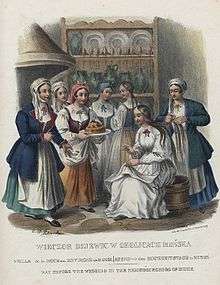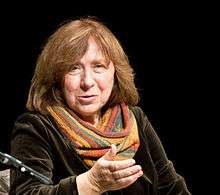Women in Belarus
The modern-day characteristics of women in Belarus evolved from the events that happened in the history of Belarus, particularly when the "concept of equal rights for women was first developed and substantiated in the late 16th century". The so-called Grand Duchy Charter of 1588 - one of the most important legal documents in Belarusian history - protected the dignity of Belarusian women under the law.[3] Women in Belarus and their contribution to Belarusian society is celebrated annually on the 8th of March, during International Women's Day.[4]
 A group of Belarusian women, wearing their national costumes, while getting the bride (seated) ready for her wedding day, dated before 1841. | |
| Gender Inequality Index[1] | |
|---|---|
| Value | 0.130 (2017) |
| Rank | 31st out of 152 |
| Maternal mortality (per 100,000) | 4 (2015) |
| Women in parliament | 33.1% (2017) |
| Females over 25 with secondary education | 87.0% (2017) |
| Women in labour force | 62% (2014)[2] |

Population
In 2000, 53% of the population of Belarus was female. The 2017 estimated median age for Belarusian women is 43.1.[5] Most Belarusian women fall into the 25-54 age range.
The average life expectancy for Belarusian women is at around 74 years old.[4]
Role in society
In Belarus, gender roles still remain very traditional. Some of these roles assigned to women are deeply seated in the country's patriarchal culture. One obligation for women, usually a mother or wife, is that they must set the dinner table. It would be considered degrading for a man to perform this task. Caring for the household and the rearing of children are also traditionally delegated to them. Traditionally, caring for children under the age of 14 is often left to mothers, and the fathers often don't interfere. Men are often looked at as more powerful than women because they are considered to be the breadwinners of the family, while women are tasked with the domestic work and childcare. Part of the problem in Belarus is that many people are unable to recognize the social injustice in the low status of women. This stems from the fact that many Belarusian women do recognize their interests and rights as specifically women's issues and because of this there is not much opposition to the situation.[4]
Women in the Workforce
Article 14 of the Labor Code of the Republic of Belarus prohibits any discrimination in labor relations, but in spite of this gender inequality is still persistent. A Belarusian woman's average salary is currently 80% of the average salary of Belarusian man, despite having legal provisions established that require equal pay for equal work. The way bonuses are distributed is what causes this discrepancy to result. It is also found to be more likely that a woman will agree to agree to a lower-paying job than a man. For certain jobs in Belarus using women's labor is actually against the law. The country has an official list of jobs that women are not allowed to partake in. Women also have a mandatory paid maternity leave for 126 days and a mandatory paid parental leave for 969 days. Jobs on the list are jobs associated with hazardous industries, increased physical activity or ones that are considered dangerous to health. Despite the gender inequality present in the work force women actually exceed the number of men employed in Belarus, as they constitute 54% of the labour market. In spite of constituting a higher percentage of the labor market, women are still less financially stable than men.[6]
Organizations for women
Feminist groups in Belarus first appeared in 1991, and then more were formed onwards. These organizations included the Union of Women in Belarus (formerly known as the Belarusian Committee of Soviet Women), the League of Women in Belarus, the Committee of Soldiers' Mothers, the Women's Christian-Democratic Movement, the Belarusian feminist movement "For the Renaissance of the Fatherland", the League of Women-Electors, and the Women's Liberal Association.[4] The beginning of the 21st century brought a change in the women's movement in Belarus. The movement started to become more structured and as a result the most effective women's organizations emerged with more defined priorities. The “Hope” party which was actually established in 1994 chose to focus on the problem of women’s involvement in politics. Another organization that emerged was the Young Women’s Christian Association of Belarus and their main focus is on the issue of the white slave trade. The Belarusian Organization of Working Women primarily deals with human rights and social issues in the country. One of the most prominent women's organization to emerge was the Women’s Independent Democratic Movement. The organization promotes political and economic competence among all citizens as well as gender equality.[7]
Gender rights
Married women in Belarus are entitled to retain personal and private property, income, investments, and other assets earned by them.[4]
See also
References
- "Table 4: Gender Inequality Index". United Nations Development Programme. Retrieved 12 May 2019.
- http://data.worldbank.org/indicator/SL.TLF.ACTI.FE.ZS/countries
- Belarusian Women as seen Through an Era, United Nations in Belarus.
- Belarus, everyculture.com
- "The World Factbook — Central Intelligence Agency". www.cia.gov. Retrieved 2018-10-11.
- "What Are Gender Rights and Opportunities in Belarus?". Office for a Democratic Belarus. 2015-04-13. Retrieved 2019-04-30.
- https://pl.boell.org/sites/default/files/downloads/Women_movement_in_Belarus.pdf
External links
| Wikimedia Commons has media related to Women of Belarus. |
- Belarus, Countries and Their Cultures
- Women's Day In Belarus: Celebrating The Real Heroes, Belarus Digest, 08 March 2012
- Lalo, Alexei and Nikolai Schitov. Sexualities in Belarus: Some Major Patterns of Sexual Behavior in Society and Their Cultural Background, June 12–16, 2001

.svg.png)